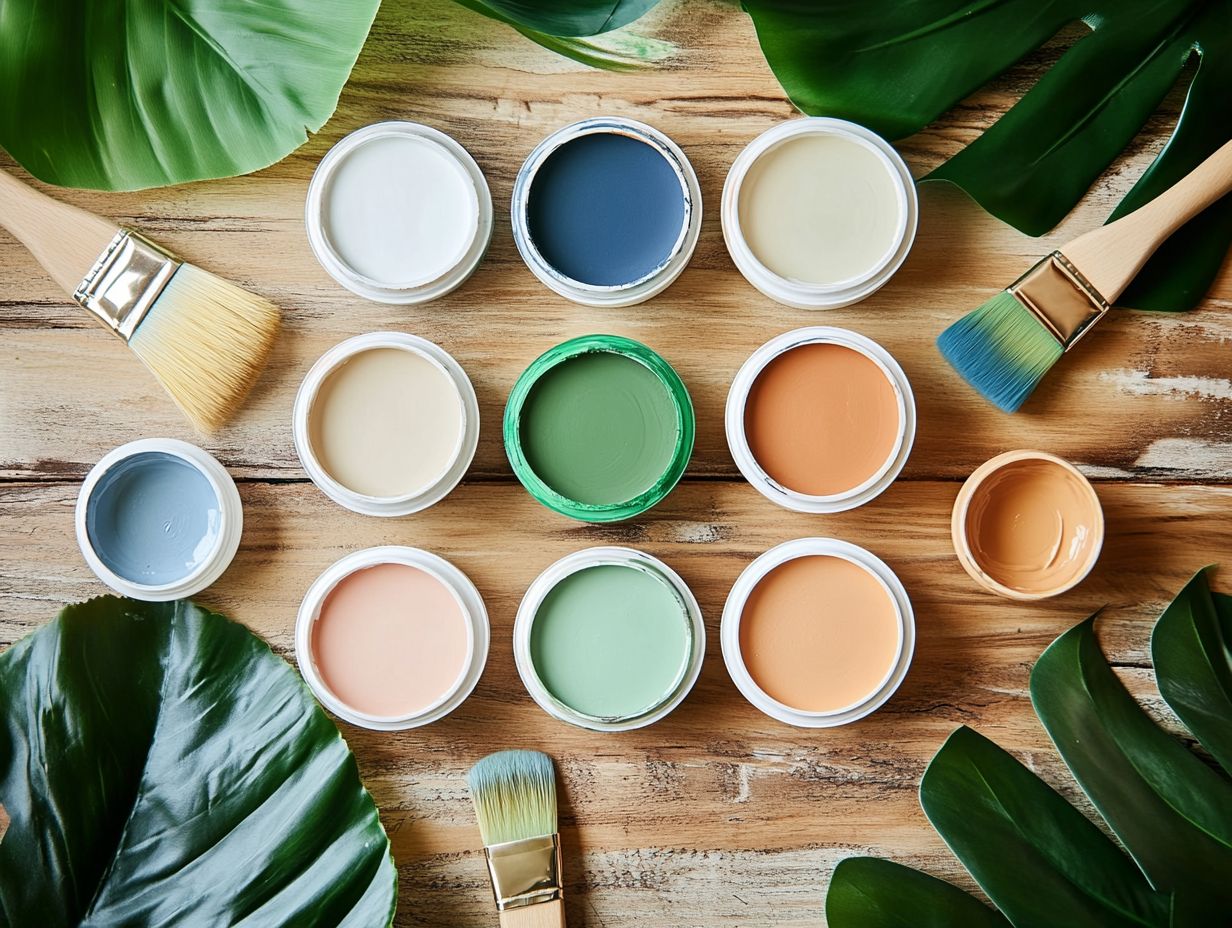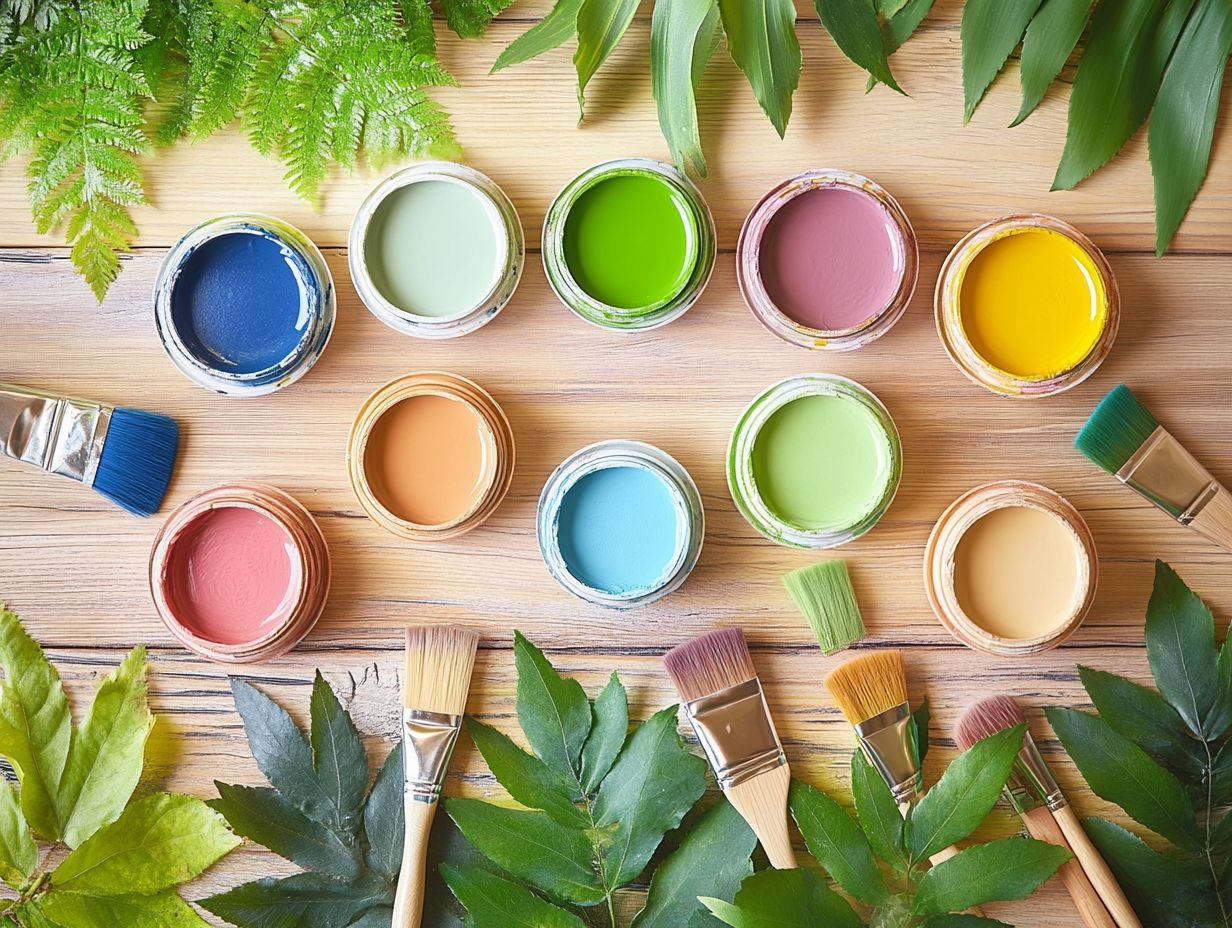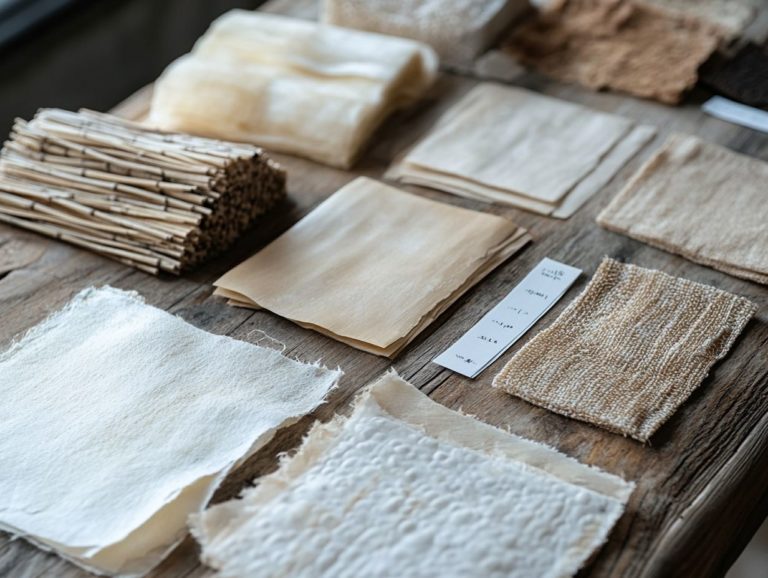5 Sustainable Paint Options for Your Home
Choosing the right paint for your home can significantly influence not only the aesthetics but also the environmental impact.
As you, the discerning homeowner, become more eco-conscious, the popularity of sustainable paint options is on the rise.
Let s dive into five eco-friendly alternatives, ranging from natural paints crafted with plant-based ingredients to innovative recycled and low levels of harmful chemicals options.
You ll discover the myriad benefits of these paints, learn how to responsibly dispose of old ones, and find tips for selecting the best choice tailored to your space.
Dive in to uncover how you can transform your next painting project into a harmonious blend of beauty and sustainability!
Contents
- Key Takeaways:
- 1. Natural Paints Made from Plant-Based Ingredients
- 2. Recycled Paints Made from Post-Consumer Waste
- 3. Low- or Zero-VOC Paints
- 4. Milk Paints
- 5. Clay Paints
- What Makes a Paint Sustainable?
- How Do These Sustainable Paints Compare to Traditional Paints?
- What Are the Benefits of Using Sustainable Paints?
- How Can One Properly Dispose of Old Paints?
- What Are the Cost Differences between Sustainable and Traditional Paints?
- How Can One Determine Which Sustainable Paint Option Is Best for Their Home?
- Frequently Asked Questions
- What are the benefits of using sustainable paint options for my home?
- What are some examples of sustainable paint options for my home?
- How do sustainable paint options compare to traditional paint?
- Can I find sustainable paint options in a variety of colors?
- Are there any other tips for using sustainable paint options in my home?
- How can I ensure I am choosing a truly sustainable paint option?
Key Takeaways:

- Choose natural paints made from plant-based ingredients for a sustainable and eco-friendly option that is also safe for your health.
- Consider recycled paints made from post-consumer waste to reduce the amount of waste that ends up in landfills and give new life to old materials.
- Opt for low or zero levels of harmful chemicals paints to improve indoor air quality and reduce harmful substances in your home.
1. Natural Paints Made from Plant-Based Ingredients
Natural paints crafted from plant-based ingredients are transforming the painting industry. They present an eco-friendly alternative that elevates aesthetic appeal while prioritizing health and safety.
With non-toxic ingredients and low levels of harmful chemicals, these paints ensure better indoor air quality for both your home and business.
Brands like Real Milk Paint and Ecos Paints exemplify this remarkable shift. They use organic materials that are safer for the environment and your health.
These products avoid toxic chemicals typically found in conventional paints, which can lead to health issues, from respiratory problems to skin irritations.
By choosing plant-based ingredients, you significantly reduce harmful emissions and enhance indoor air quality. Certifications such as Greenguard Gold and the Declare Label offer you trustworthy assurance that these paints meet stringent safety standards.
This makes them a savvy choice for eco-conscious consumers who seek safer options without compromising on style.
2. Recycled Paints Made from Post-Consumer Waste
Recycled paints, crafted from post-consumer waste, mark a significant stride toward eco-friendly painting solutions. By choosing these paints, you contribute to reducing landfill waste while championing sustainable practices within the industry.
This innovative process begins by collecting leftover paint from various sources. It is then meticulously screened, reprocessed, and blended into new, usable products.
When you opt for these paints, you re not just supporting the recycling economy; you re also benefiting from fewer harmful chemicals and lower VOC emissions compared to traditional options.
This translates to improved indoor air quality and safer environments for your family and pets. Using recycled paint can significantly reduce your carbon footprint, aligning seamlessly with green initiatives.
Keep an eye out for labels like EcoLogo or Green Seal; these reliable markers identify products that adhere to rigorous sustainability standards.
Making such choices not only elevates your space but also reflects a commitment to a healthier planet.
Act now and start your eco-friendly painting journey!
3. Low- or Zero-VOC Paints
Low- or zero-VOC paints are essential for excellent indoor air quality. They minimize harmful volatile organic compounds (VOCs), which are harmful chemicals that can evaporate into the air.
These paints help prevent health issues. They’re the go-to choice for eco-conscious consumers and design professionals alike.
Understanding the differences between low-VOC and zero-VOC paints is crucial. Low-VOC paints contain a limited amount of volatile organic compounds, while zero-VOC paints effectively contain none, creating an even safer environment for your space. Both options typically comply with building codes aimed at promoting healthier living areas, but it s essential to seek out third-party certifications like Green Seal or GREENGUARD for peace of mind regarding their safety claims.
Renowned brands such as Benjamin Moore and Behr have fully embraced this shift, offering a variety of products that align with sustainability goals. This commitment not only enhances air quality but also fosters healthier living environments, all without compromising on aesthetics.
4. Milk Paints

Milk paints, crafted from biodegradable materials and organic ingredients, present an eco-friendly option that doesn t compromise on beauty or safety. You can enjoy a stunning finish without the health risks typically associated with conventional paints.
Milk paints use milk proteins, lime, and natural pigments. This ensures excellent adhesion while aging gracefully. Their unique formula enhances the aesthetic of your surfaces and improves indoor air quality.
Designers and homeowners are increasingly drawn to these paints, thanks to their low VOC content and the vast array of colors available. Renowned brands like Real Milk Paint and Mythic Paint offer a dazzling array of shades, making it effortless for you to incorporate these eco-conscious choices into your design projects. Whether you’re refinishing furniture or creating accent walls, the versatility of milk paints opens the door to endless creative possibilities.
5. Clay Paints
Clay paints are made from natural pigments and eco-friendly materials. They are an excellent choice for sustainable interior design. These paints also foster healthier indoor environments by minimizing pollution.
Not only do these paints deliver a distinctive aesthetic with their matte finish and earthy tones, but they also boast impressive breathability, which is the ability of walls to absorb and release moisture. This feature helps maintain balanced humidity levels in your living spaces, enhancing overall comfort.
With low levels of volatile organic compounds (VOCs), clay paints ensure cleaner air, making them an excellent option for families and individuals with sensitivities. Many of these paints come with certifications like Green Seal or Cradle to Cradle, affirming their commitment to sustainability and environmental stewardship, aligning seamlessly with eco-friendly design principles.
What Makes a Paint Sustainable?
A paint can be considered sustainable when it s crafted with eco-friendly ingredients, adheres to rigorous certification standards, and minimizes harmful health hazards. This approach ensures a reduced environmental impact throughout its entire lifecycle, from production to disposal.
When assessing sustainability, consider the sourcing of raw materials, focusing on the use of renewable or recycled components that help lessen resource depletion. Production practices should limit emissions and waste, concentrating on processes that reduce energy consumption.
Effective disposal methods, such as biodegradable formulations or robust recycling programs, further enhance a product’s environmental benefits. Certifications from esteemed organizations like the Environmental Protection Agency (EPA) and the California Air Resources Board validate these sustainability claims, providing you with peace of mind that you are making responsible choices for the planet.
How Do These Sustainable Paints Compare to Traditional Paints?
Sustainable paints set themselves apart from traditional options through their significantly lower VOC levels (volatile organic compounds that can affect air quality) and non-toxic ingredients. Enjoy cleaner air at home with sustainable paints!
These environmentally conscious alternatives are crafted from natural sources. This effectively eliminates harmful compounds that can contribute to respiratory issues and environmental degradation.
Sustainable paints can have VOC levels as low as 0-10 grams per liter, while traditional paints often exceed 100 grams per liter. A study by the Environmental Protection Agency highlights that low-VOC paints not only pose fewer risks but also enhance air quality and overall well-being for residents.
The absence of toxic chemicals like formaldehyde and heavy metals in sustainable options makes them a safer choice for families and vulnerable populations. This underscores their increasing significance in modern construction and decor.
What Are the Benefits of Using Sustainable Paints?

Utilizing sustainable paints offers numerous benefits. These paints enhance indoor air quality and reduce health risks from harmful chemicals. You also make a positive impact on the environment through responsible sourcing and production practices.
Incorporating these eco-friendly choices elevates the aesthetic appeal of your spaces. They align seamlessly with contemporary design trends that emphasize sustainability.
Reputable green labels, like Green Seal or ENERGY STAR, often certify these paints. This ensures they adhere to stringent safety and environmental standards.
For instance, switching to sustainable options can reduce VOC levels by up to 80%, creating healthier environments for you and those around you.
These paints contribute to greener building solutions and can potentially earn your projects LEED certification. This supports ongoing efforts to foster healthier living and working spaces for everyone.
How Can One Properly Dispose of Old Paints?
Proper disposal of old paints is essential. This not only helps you avoid health risks posed by toxic chemicals but also fosters eco-friendly habits.
Start by checking local regulations regarding paint disposal, as these can vary widely. It’s crucial to avoid pouring leftover paint down the drain. This can contaminate water supplies and damage local ecosystems.
Look for designated hazardous waste collection days organized by your local municipality. These often provide a safe outlet for unwanted paints.
Many communities offer recycling programs or drop-off centers specifically for paint. This makes it easier for you to dispose of your materials responsibly while supporting environmental sustainability efforts. By following these practices, you contribute to a healthier environment for everyone.
What Are the Cost Differences between Sustainable and Traditional Paints?
The cost differences between sustainable paints and traditional paints reflect the quality of materials used. Sustainable options typically have a higher price due to their environmentally friendly focus and commitment to green certification standards.
Several factors contribute to this price divergence. Sourcing raw materials for sustainable paints often involves practices that prioritize environmental care, which can limit availability and increase costs. Eco-friendly brands prioritize production methods that protect the environment and require investments in cleaner technologies and processes.
Certifications such as Green Seal or EcoLabel can also elevate prices. These certifications guarantee adherence to stringent environmental standards. Brands like Benjamin Moore s Natura line and Behr Premium Plus offer sustainable choices ranging from $30 to $70 per gallon, while traditional paints can start at just $15 per gallon.
Choosing sustainable paints is a fantastic way to support eco-conscious practices and improve indoor air quality. It’s a choice you can feel good about!
How Can One Determine Which Sustainable Paint Option Is Best for Their Home?
Determining the best sustainable paint option for your home requires thoughtful evaluation. Consider factors such as indoor air quality, any existing health concerns related to chemical exposure, and the eco-friendliness of the materials. Additionally, learning how to choose sustainable materials for your home can enhance your decision-making. Consulting with design professionals can provide invaluable insights.
Reflect on how each room will be utilized. Note specific activities that might influence your color choices or finishes. For example, a vibrant hue can invigorate a playroom, while calming shades enhance the tranquility of a bedroom.
Next, consider your personal aesthetics alongside the latest trends to create a harmonious environment. Prioritizing paints with certifications like Green Seal or GREENGUARD is crucial, as they indicate low emissions and a commitment to environmental responsibility.
Don t hesitate to seek advice from professional painters or interior designers. Their tailored recommendations can help you achieve your individual goals, ensuring that your choices benefit both your home and your health.
Frequently Asked Questions

What are the benefits of using sustainable paint options for my home?
Using sustainable paint options for your home offers environmental and health benefits. Sustainable paints are made with non-toxic ingredients, reducing harmful chemicals released into your home. To enhance your space further, consider these 5 ways to integrate sustainable materials in decor, as they also have a smaller carbon footprint and promote healthier indoor air quality.
What are some examples of sustainable paint options for my home?
Examples of sustainable paint options include milk paint, plant-based paint, clay paint, natural oil paint, and recycled paint. These options use eco-friendly and non-toxic ingredients, making them a great choice for the environment and your health, just like sustainable flooring options for your home.
How do sustainable paint options compare to traditional paint?
Sustainable paint options typically have a higher price point than traditional paint, but their benefits far outweigh the costs. Traditional paint contains harmful chemicals that can negatively impact your health and the environment, while sustainable paints are made with natural and non-toxic ingredients.
Can I find sustainable paint options in a variety of colors?
Yes, sustainable paint options come in a wide range of colors, just like traditional paint. You can easily find the perfect shade for your home.
Are there any other tips for using sustainable paint options in my home?
When using sustainable paint options, it’s important to properly dispose of any leftover paint. Many sustainable paints can be composted or recycled, reducing waste and further promoting sustainability.
Explore the world of sustainable paints today and make a choice that benefits both you and the planet!
How can I ensure I am choosing a truly sustainable paint option?
Looking to make an eco-friendly choice? Choose paints with certifications or labels like Green Seal or LEED. These guarantee that your paint is safe for you and the planet.






